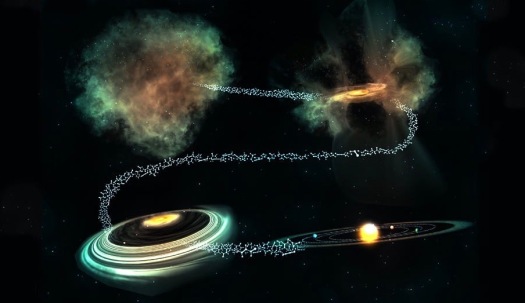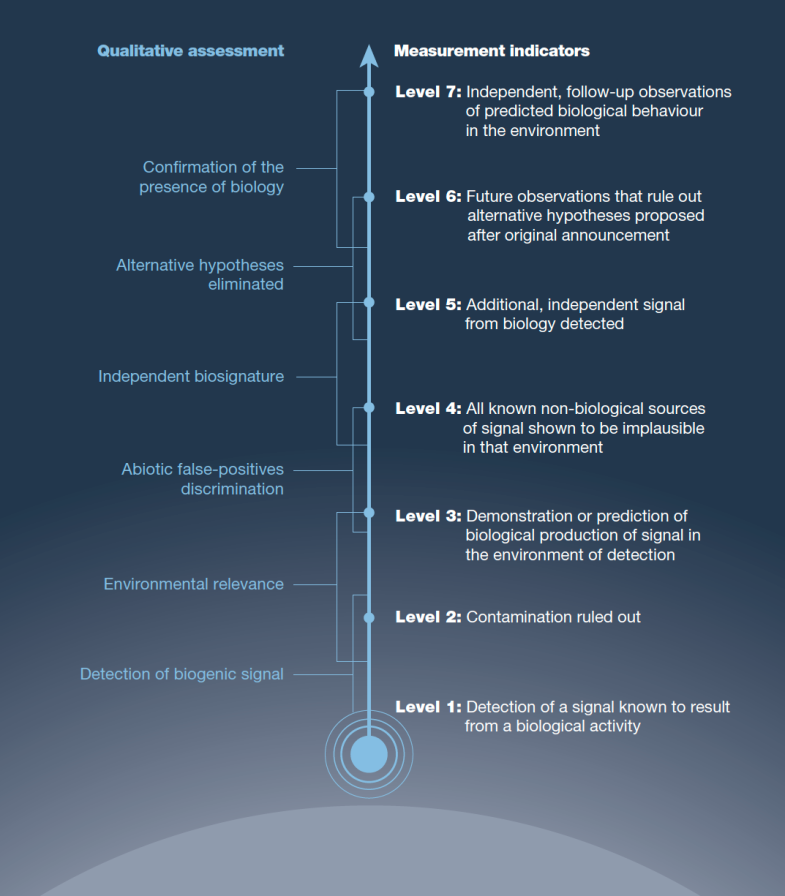
The global scientific search for signs of life beyond Earth has produced cutting-edge and paradigm-shifting science for several decades now, and it has clearly found eager audiences around the world. This search is a high-priority goal of NASA and other space agencies, as well as institutions, universities and companies.
While the successes in this broadly defined field of astrobiology are legion, the field has also struggled with a problem that flows precisely from its high-impact subject.
That problem is how to best keep its scientific claims evidence based and how to take into account all the myriad factors that can undermine the strength of a “finding.” And then comes the question of how to best communicate with the public the nature of the findings and all the caveats involved.
There appears to be a widely-held view that some scientific claims and media reports about potential life beyond Earth have become not only a distraction in the field, but have served to undermine some public confidence in the endeavor.

And some of the leading figures in the field have written a paper, released today by the journal Nature, that calls for the creation of some as yet undefined guardrails or confidence scales to make exciting scientific findings and news about astrobiology more consistently dependable.
The goal is to find ways to make sure that papers meet the widely-embraced Carl Sagan standard that “extraordinary claims require extraordinary evidence”.
This is how the authors introduce the paper:
“Ours could realistically be the generation to discover evidence of life beyond Earth. With this privileged potential comes responsibility.”
“The magnitude of the question, “are we alone?”, and the public interest therein, opens the possibility that results may be taken to imply more than the observations support, or than the observers intend. As life detection objectives become increasingly prominent in space sciences, it is essential to open a community dialogue about how to convey information in a subject matter that is diverse, complicated, and has high potential to be sensationalized.”
“Establishing best practices for communicating about life detection can serve to set reasonable expectations on the early stages of a hugely challenging endeavor, attach value to incremental steps along the path, and build public trust by making clear that ‘false starts’ and ‘dead ends’ are an expected and potentially productive part of the scientific process. ”

While a primary goal outlined in the paper is to increase confidence in future astrobiology results, it also highlights what it describes as a frequent misconception: That an experiment or mission can be judged positively or rejected as falling short based on whether it found extraterrestrial life — or some other major discovery — or did not.
That approach seems to lead to reported results that overly emphasize the possibility that extraterrestrial life has been found or is close to being found. But it also ignores the essential findings that become part of the pathway for future life-detection efforts.
“Until now, we have set the public up to think there are only two options: it’s life or it’s not life,” said Mary Voytek, head of NASA’s Astrobiology Program in Washington and study co-author. “We need a better way to share the excitement of our discoveries, and demonstrate how each discovery builds on the next, so that we can bring the public and other scientists along on the journey.”
The Nature paper presents a possible framework for both assessing the significance of a finding and describing in specifics what bars the discovery has or has not cleared.

They stress that it is up to the scientists of the astrobiology community to create and implement their own confidence framework. But they also present a possible candidate, “an example of how such considerations might be incorporated and applied in a proof-of-concept-level framework.”
The authors’ vision is that in the future, scientists will note in published studies how their new astrobiology results fit into a “Confidence of Life Detection” (CoLD) scale. Journalists would also be encouraged to refer to this framework to set expectations for the public in stories about new scientific results, so that small steps don’t appear to be major leaps.
While the exact details of the scale will evolve as scientists, communicators, and others weigh in, the Nature article offers a starting point for discussion.
As described in a NASA release, at the first step of the scale, “level 1,” scientists would report hints of a signature of life, such as a biologically relevant molecule. An example would be a future measurement of some molecule on Mars potentially related to life. Moving up to “level 2,” scientists would ensure that the detection was not influenced by the instruments having been contaminated on Earth. At “level 3” they would show how this biological signal is found in an analog environment, such as an ancient lakebed on Earth similar to the Perseverance rover’s landing site, Jezero Crater.
To add evidence to the middle of the scale, scientists would supplement those initial detections with information about whether the environment could support life, and rule out non-biological sources. For Mars in particular, samples returned from Mars could help make this kind of progress. Perseverance will soon be collecting and storing samples with the goal of a future mission returning them one day.
Since different teams on Earth would have the opportunity to independently verify hints of life in Mars samples with a variety of instruments, the combination of their evidence could achieve “level 6,” the second highest step on the scale. But in this example, to reach level 7, the standard by which scientists would be most sure they had detected life on Mars, an additional mission to a different part of Mars may be required.
Under the auspices of two NASA astrobiology initiatives — the Nexus for Exoplanet System Science ( NExSS) and Network for Life Detection (NfoLD) — a virtual workshop was held in July with many astrobiologists and planetary scientists who began hearing out what the larger community sees as necessary and workable standards for addressing the complexity of life detection.

The need for the kind of standards the authors call for is to some extent a function of the kind of missions NASA has embraced.
The Perseverance mission on Mars, for instance, is defined as a “life detection” mission because it carries instruments that could detect signatures of potential microbial life past or present. The Europa Clipper is not officially a “life detection” mission, but it is going to a Jovian moon thought to possibly harbor life in its global ocean beneath a covering of ice. Periodically, it seems, it releases plumes of vapor that could potentially be collected and analyzed. And the Saturn’s moon Enceladus more regularly spews water vapor into space from its ice-covered global ocean – another possible home for biology.
Said NASA Chief Scientist Jim Green: “Finding life beyond Earth is a major goal of NASA. Yet it is clear that the detection of extraterrestrial life will likely be neither instantaneous nor unambiguous—and yet it is a high stakes scientific achievement that will garner enormous public interest.
“It is more important than ever that we strive to convey accurate information on a topic that is inherently complex and interdisciplinary. I believe that a progressive framework that reports a series of results along the path to attaining a more definitive detection of life is our best approach.”
Also authoring the “Call to Action” are Tori Hoehler of NASA Ames, Marc Neveu of the University of Maryland and NASA Goddard, Shawn Domagal-Goldman of NASA Goddard and Daniella Scalice of the NASA Astrobiology Program.
The results of the July workshop meetings on how the larger astrobiology community wants to progress will be coming out soon.
As reported by Voytek, “The workshop folks are working madly to post the white paper for public comment by the end of the week. They will also collect signatories.”
She said the White Paper will then be reviewed by CAPS (the Committee on Astrobiology and Planetary Science of the National Academy of Sciences.) The review will begin with presentations at their November meeting.
The need for the kind of standards the authors call for is to some extent a function of the kind of missions NASA has embraced.
The Perseverance mission on Mars, for instance, is defined as a “life detection” mission because it carries instruments that could detect signatures of potential microbial life past or present. The Europa Clipper is not officially a “life detection” mission, but it is going to a Jovian moon thought to possibly harbor life in its global ocean beneath a covering of ice. Periodically, it seems, it releases plumes of vapor that could potentially be collected and analyzed. And the Saturn’s moon Enceladus more regularly spews water vapor into space from its ice-covered global ocean – another possible home for biology.
Said NASA Chief Scientist Jim Green: “Finding life beyond Earth is a major goal of NASA. Yet it is clear that the detection of extraterrestrial life will likely be neither instantaneous nor unambiguous—and yet it is a high stakes scientific achievement that will garner enormous public interest.
“It is more important than ever that we strive to convey accurate information on a topic that is inherently complex and interdisciplinary. I believe that a progressive framework that reports a series of results along the path to attaining a more definitive detection of life is our best approach.”
Also authoring the “Call to Action” are Tori Hoehler of NASA Ames, Marc Neveu of the University of Maryland and NASA Goddard, Shawn Domagal-Goldman of NASA Goddard and Daniella Scalice of the NASA Astrobiology Program.
The results of the July workshop meetings on how the larger astrobiology community wants to progress will be coming out soon.
As reported by Voytek, “The workshop folks are working madly to post the white paper for public comment by the end of the week. They will also collect signatories.”
She said the White Paper will then be reviewed by CAPS (the Committee on Astrobiology and Planetary Science of the National Academy of Sciences.) The review will begin with presentations at their November meeting.

2 Replies to “A Call To Action on Ensuring That Extraordinary Claims About ET Life Come With Extraordinary Evidence”
Comments are closed.